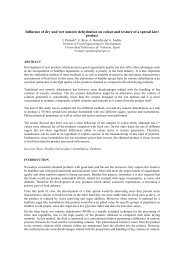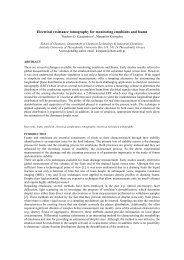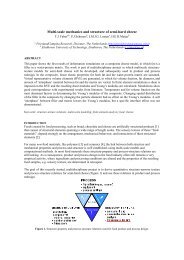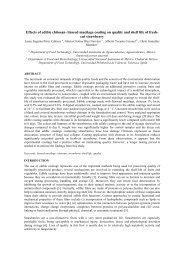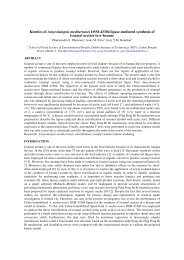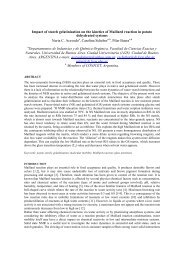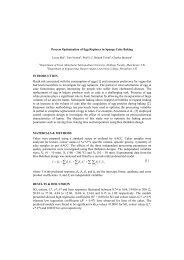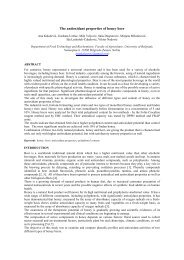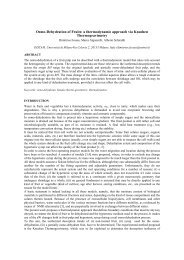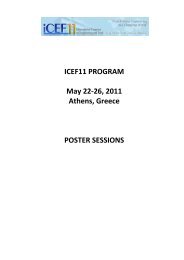Functional properties of foods. Database and model prediction
Functional properties of foods. Database and model prediction
Functional properties of foods. Database and model prediction
You also want an ePaper? Increase the reach of your titles
YUMPU automatically turns print PDFs into web optimized ePapers that Google loves.
St<strong>and</strong>ard Deviation<br />
WAI .<br />
different relationship concerning more predictor variables is more appropriate. In general, the agreement<br />
between the experimental data <strong>and</strong> the estimated values is reasonably good.<br />
10<br />
Χ = 20 % (wb) S = 180 (rpm)<br />
9<br />
Starch<br />
8<br />
7<br />
Rice<br />
6<br />
5<br />
Corn<br />
Beans<br />
4<br />
3<br />
Barley<br />
Wheat<br />
2<br />
1<br />
Oat<br />
0<br />
80 110 140 170 200 230 260<br />
Die Temperature ( o C)<br />
WSI % .<br />
50<br />
Χ = 15 % (wb) S = 200 (rpm)<br />
45<br />
40<br />
35<br />
Beans<br />
Rice<br />
30<br />
Starch<br />
25<br />
20<br />
15<br />
10<br />
5<br />
0<br />
Wheat<br />
Corn<br />
Oat<br />
80 110 140 170 200 230 260<br />
Die Temperature ( o C)<br />
Figure 1. Effect <strong>of</strong> die temperature ( o C) on WAI (left) <strong>and</strong> WSI (right) for barley (▲), corn (●), oat (■), rice (x), wheat<br />
(◊), beans (○) <strong>and</strong> starch (□). Lines are calculated <strong>model</strong> values using parameters given in Table 2<br />
16<br />
12<br />
8<br />
Lack <strong>of</strong> fit<br />
4<br />
0<br />
Experimental<br />
error<br />
0 1 2 3 4 5<br />
Number <strong>of</strong> Parameters<br />
Figure 2. The st<strong>and</strong>ard experimental error (Se) <strong>and</strong> lack <strong>of</strong> fit (Sr) as a<br />
function <strong>of</strong> the number <strong>of</strong> parameters for WAI <strong>model</strong>; case <strong>of</strong> rice<br />
Table 3. St<strong>and</strong>ard experimental error (Se), st<strong>and</strong>ard deviation between experimental <strong>and</strong><br />
calculated values (Sr) <strong>and</strong> the parameters <strong>of</strong> the <strong>model</strong> for the PDI <strong>prediction</strong><br />
Food System Se Sr a b c<br />
Beans (P. vulgaris L.) meal 2.83 3.23 16.58 -0.98 -0.05<br />
Canola meal 1.55 1.98 21.57 -2.08 0.11<br />
Soy flour 3.34 14.45 16.22 -3.26 -0.10<br />
Soybean 0.62 3.18 27.08 -0.01 -0.06<br />
The variety <strong>of</strong> experimental PDI values ranges from 6.2 to 96.8 while, PDI predicted vary from 6.6 to 46.8<br />
for all products. The smaller range <strong>of</strong> predicted values compared to experimental values may be explained by<br />
the low ability <strong>of</strong> the <strong>model</strong> to predict accurate values mainly at high values <strong>of</strong> independent variables. The<br />
scatter plot, which relates the PDI with residence time <strong>of</strong> products at three different temperatures for beans



